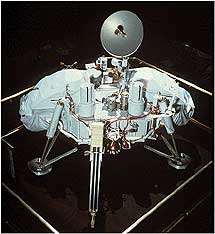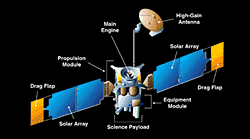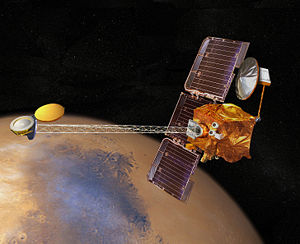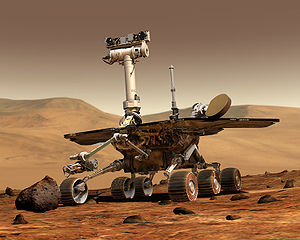Planetary Probes
- Mercury
- Venus
- Mars
- Outer Planets
- Satellites
Space Probes
MARS PLANETARY PROBES
 VIKING 1 & 2
VIKING 1 & 2
Vikings 1 and 2 became the first space probes to successfully land on the surface of Mars. Viking Lander 1 was the first U.S. spacecraft to successfully touch down on any planet other than Earth. Both spacecraft were launched in 1976, the year in which the United States celebrated its bicentennial. The Viking probes analyzed gases in the Martian atmosphere and chemicals in the soil for evidence of the existence of simple life. The Viking image of Marsprobes also measured wind speed, wind direction, atmospheric temperature, and atmospheric pressure. The Viking orbiters mapped the Martian surface.
 MARS GLOBAL SURVEYOR
MARS GLOBAL SURVEYOR
In November of 1996, Mars Global Surveyor began a 10-month mission to the Red Planet. The space probe was caught by Mars' gravitational pull and swung into an elliptical orbit around the planet. Onboard detectors measured radiation to determine the minerals that make up Global Surveyor image of MarsMars. The detectors also measured the composition, pressure, water content, dust content, and changes in the Martian atmosphere. This study of Mars continued for two years. At its completion, the Surveyor mission compiled an extensive record of the planet. This information will help in the planning of future missions, which may include human landings.
 MARS PATHFINDER
MARS PATHFINDER
On July 4, 1997, after a 7-month journey, Pathfinder entered the Martian atmosphere. Minutes later, its airbag-cocooned lander bounced to a stop on the Martian surface. The Pathfinder lander, now known as the Sagan Memorial Station, carried onboard a robotic rover named Sojourner. The 10 kilogram solar-powered rover was equipped with a spectrometer used to analyze the chemical composition of Martian rock and a camera which relayed images of the landscape back to Earth. The Pathfinder lander and the Sojourner rover sent thousands of images, more than 15 analyses of Martian rocks and data on weather condition to scientists on Earth. The low-cost mission has been said to set the standard for 21st century space exploration.
 MARS ODYSSEY
MARS ODYSSEY
NASA launched the Mars Odyssey space probe on April 7, 2001 on a mission to use spectrometers and electronic imagers to hunt for evidence of past or present water and volcanic activity on Mars. It reached its final destination in orbit around Mars on February 2002. Over the past few years, Odyssey has succesfully mapped the amount and distribution of many chemical elements and minerals that make up the martian surface. Of which, the maps of hydrogen distribution led scientists to discover vast amounts of water ice in the polar regions burried just beneath the surface. Currently, the Odyssey mission is still in effect and has enough propellant to last until 2015.
 MARS EXPLORATION ROVER (SPIRIT & OPPORTUNITY)
MARS EXPLORATION ROVER (SPIRIT & OPPORTUNITY)
The twin Rovers, Spirit and Opportunity landed on Mars January 3, 2004 and January 24, 2004, respectively. Since that time, Opportunity has travelled a distance of about 13 miles; Spirit has been stuck in martian soil for a couple of months so now it has been permanently converted to a stationary research platform. As of January 3, 2009, they have transmitted over 250,000 images of the martian terrain and still transmitting. We have learned so much from the ongoing research of these two rovers and the massive amount of information they've collected, so in their honor two asteroids were named after them: 37452 Spirit and 39382 Opportunity.